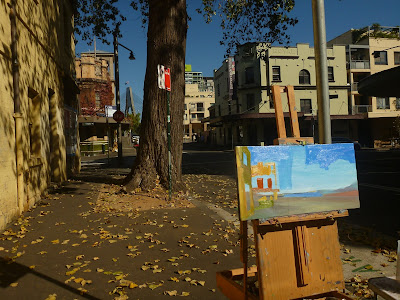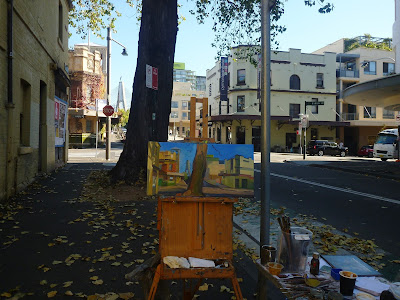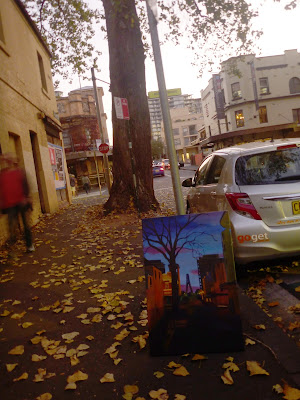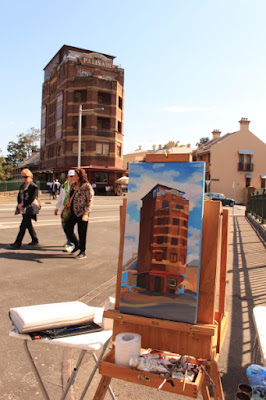The Terminus Hotel has been sold at last.
I've heard that the new owners intend to relaunch it as a boutique hotel, over 30 years after it last traded. The Pyrmont Point Hotel will finally have its old competition back.
The 'For Sale' sign is still perched on its awning, so I thought that I would paint a few canvases before the renovations start in earnest.

Starting a plein air oil painting of the Terminus Hotel,
corner of Harris and John streets, Pyrmont.
I'll be curious to see how this poster-child for urban decay will look after renovation.
The vines covering most of the northern facade of the Terminus, which add to its 'Miss Havisham' air, will probably have to be removed.
The vines are actually Virginia creeper, not ivy, as is commonly stated.
The old late Victorian mansion behind the Harris street tennis courts, which used to belong to the CSR Refinery Manager, has a similar covering of Virginia creeper. The 'Rum Store' of the former CSR Refinery, and current Jacksons Landing development, used to also be completely covered in this spectacular vine.
I particularly love painting the Terminus Hotel in late autumn, as the Virginia creeper is changing colour from lime green to burgundy over the burnt orange Federation brickwork.
Burgundy, claret and wine colours seem appropriate to an old hotel.
This might be the last autumn to paint the vines.

Starting a plein air oil painting of the Terminus Hotel,
corner of Harris and John streets, Pyrmont.
Available
The legs of the Anzac Bridge straddle the end of John street. It is easier to see in autumn, as the plane trees are losing the leaves which obscured them.

Starting a plein air oil painting of the Terminus Hotel,
corner of Harris and John streets, Pyrmont.
During the demolition decade of the 1990s many Pyrmont hotels stopped trading : the New York in Edward Street, the Pyrmont Arms at 42 Harris Street, the pub on the corner of Mount and John street. These are now, respectively, a medical centre; apartments above a bottle shop and yet more apartments.

Starting a plein air oil painting of the Terminus Hotel,
corner of Harris and John streets, Pyrmont.
Available Other attractive heritage buildings and quirky industries disappeared without trace. Nobody really remembers much about what happened to them. The Terminus seemed to always have had an intangible charisma that set it apart from the rest. Why, out of all of these neglected and forgotten buildings did the Terminus alone become a legend?
Starting a plein air oil painting of the Terminus Hotel,
corner of Harris and John streets, Pyrmont.
How any of the pubs except the Pyrmont Bridge Hotel survived the Pyrmont diaspora decade of the mid 1980s - late 1990s is possibly the greatest mystery of all.
One reason it was so hard to pin down when the Terminus was finally shut is that by the end of the 80s, Pyrmont in the daytime was nearly deserted.

Starting a plein air oil painting of the Terminus Hotel,
corner of Harris and John streets, Pyrmont.
The industries that provided the customers for the traditional 'early opener' pubs were winding down and moving out. The last sugar ship left in 1991 or 1992; the CSR were winding down their operations and had only a skeleton staff; Pier 19, 20 21 had almost ceased to be a working wharf ; the cruise ships stopped coming to Pier 13 by 1992.

Starting a plein air nocturne oil painting of the Terminus Hotel,
corner of Harris and John streets, Pyrmont.
The Royal Pacific was seriously down at heel and unless a few familiar faces were drinking there I would feel a bit ill at ease walking around there late at night as there was sometimes a fairly dodgy looking crowd there and some of the locals would say quite flatly that it used to be full of gangsters. The Terminus seemed to be mostly full of boxers & bikies, so, take your pick!

Starting a plein air oil painting of the Terminus Hotel,
corner of Harris and John streets, Pyrmont.
By the early 1990s both places seemed very quiet, day or night, so it was hard to pin down exactly when the Terminus had shut.

Starting a plein air oil painting of the Terminus Hotel,
corner of Harris and John streets, Pyrmont.
You can still see the 'ghost sign' saying 'Royal Pacific' on the eastern facade of the Pyrmont Point Hotel.
City's mysteries up for sale (smh.com.au)
For more information about the Terminus and Pyrmont Point Hotels see My Pyrmont page in this blog























